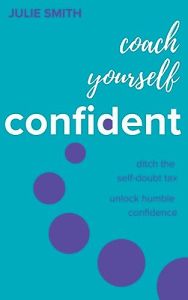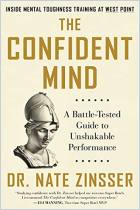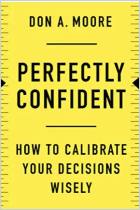Únase a getAbstract para acceder al resumen.

Únase a getAbstract para acceder al resumen.
Julie Smith
Coach Yourself Confident
Ditch the self-doubt tax, unlock humble confidence
Practical Inspiration Publishing, 2024
¿De qué se trata?
Don’t let self-doubt win: Build your confidence to enhance your personal and professional life.
Recommendation
Is a lack of confidence holding you back? Career coach expert Julie Smith empowers you to challenge your inner critic, embrace your strengths, and navigate the ups and downs of self-doubt with grace and resilience. Through personal stories, practical exercises, and evidence-based approaches, she offers a road map to a self-assured future where confidence fuels every aspect of your life. Whether you seek to enhance your professional performance, enrich your personal relationships, or simply live with greater authenticity, this guide is your essential companion on the journey to self-confidence.
Take-Aways
- Growing your confidence is essential for performance success.
- Keep self-doubt in check; don’t let your “inner critic” inhibit your growth.
- Build a level of confidence that matches your capabilities.
- Challenge how you see yourself, own your strengths, and set realistic expectations.
- Identify and tackle your “confidence saboteurs.”
- Reflect on the ebb and flow of confidence in your life.
- Don’t rely on external factors to boost your confidence; grow it from within.
Summary
Growing your confidence is essential for performance success.
Confidence plays a crucial role in maximizing and growing your skills and abilities. Consider the story, “The Little Engine That Could”: The Little Engine succeeds in climbing the mountain by telling herself, “I think I can, I think I can.” Your belief in your abilities shapes how you approach challenging tasks. A positive mindset not only helps you take the kinds of risks that enhance your life and career but also leads to a more vivid demonstration of your strengths, creating a self-fulfilling path to success. By minimizing doubts and distractions, you increase your chances of mastering the challenges you face.
“Confidence enables us to step forward and seize opportunities; it helps us to say yes.”
To understand and enhance your confidence, begin by identifying moments when you feel most and least confident, taking note of both scenarios and discerning underlying patterns that influence these feelings. Reflect on your confidence-related aspirations. Ponder the changes you wish to see, how these alterations would affect you, and how others would perceive the shift. This exercise aims to provide a clear understanding of your current confidence landscape and set specific goals for growth, focusing on the effects these changes would have on both yourself and how others view you.
Keep self-doubt in check; don’t let your “inner critic” inhibit your growth.
Self-doubt is normal; however, in excess, doubt can wreak havoc on your ability to progress and grow. The “self-doubt tax” refers to the metaphorical cost you pay when an overly harsh “inner critic” influences your decisions in ways that lead to missed opportunities and unnecessary stress or overwork due to high self-imposed standards. For instance, when receiving praise from a colleague, instead of accepting the praise, you might discredit it, saying to yourself that “you were only doing your job.” Self-doubt manifests as avoiding challenges to stay within your comfort zone or achieving through overexertion. Thus, self-doubt can both limit your potential and hinder your well-being.
“When our self-doubt is over-sized, a self-doubt tax payment becomes due.”
Take a moment and assess your inner critic. Begin by identifying the specific negative messages you frequently hear from your inner critic, noting down the phrases that resonate with your experiences of self-doubt or criticism. Next, visualize your inner critic: Imagine it as a distinct figure or object. Consider its appearance, size, and colors. Then, draw the figure you imagine. By bringing your critic into the light, you diminish its influence over you.
Mellowing your inner critic can lead to more understanding and patience. You don’t have to be perfect; in fact, trying to be perfect can increase self-doubt. Offer yourself the same compassion you would extend to a colleague in distress, treating yourself with kindness and understanding rather than harsh judgment. Treating yourself as you would others helps shift your internal narrative from self-criticism to more supportive and constructive self-talk. Engage in a practice where, in moments of self-doubt, you pause, take a breath, and ask yourself how you would advise a friend in a similar situation. Then, use this perspective to guide your response to yourself.
Build a level of confidence that matches your capabilities.
Too much confidence usually leads to trouble. So, you want to build just the right amount that matches your capabilities. This is called “humble confidence”: achieving a balanced sense of self, where confidence is neither inflated by ego nor undermined by self-doubt. When Uma Rajah was considering whether to accept an offer to become CEO of CapitalRise, for example, she carefully considered both the value she could offer the company and the areas where she’d need to grow to succeed in the role. Ultimately, she embraced the opportunity to learn and trusted that she could lean on the collective strengths of her team.
To fine-tune your humble confidence, embrace the mantra, “I am good enough, and I can be better.” This phrase allows you to acknowledge your current capabilities while remaining open to learning and improvement. Reflect on both aspects of this mantra. First, take five minutes to note down your strengths. Write, “When I’m at my best, I…” then finish the sentence. Next, ask yourself, “How can I be better?” Complete the sentence, “To make my contribution even better, I would like to…” in various ways, aiming to identify areas for improvement.
Now, compare your two lists. Consider: Was one easier to write than the other? How do your lists make you feel? Finally, reflect on the mantra “I am good enough, and I can be better” and consider how it applies to you. If you struggle to embrace this assertion, ask yourself why. This insight can be valuable in your journey toward greater confidence.
“Have faith in your capacity to grow your confidence, and try to notice and appreciate all of the steps you take along the way, however small.”
Humble confidence effectively reduces unnecessary self-doubt, decreasing the mental and emotional costs associated with it. This type of confidence brings a sense of assurance that your self-perception accurately reflects your abilities, fostering a comfortable acceptance of your individuality.
Challenge how you see yourself, own your strengths, and set realistic expectations.
How accurately do you see yourself? Do you see the same strengths that others see in you, or do you diminish your capabilities and enlarge your faults? A distorted self-perception can lead to a paradox: Despite recognizing your expertise and accomplishments, you may lack complete trust in your ability to apply your skills in new situations. To avoid this trap, take a realistic view of your strengths.
“Our lack of confidence can stem from a distortion in the way that we see ourselves.”
Taking ownership of your strengths allows for more effective access and use of your abilities, supports continuous improvement without fostering complacency, and honestly acknowledges your capabilities. Revisit and read aloud the statements from previous reflective exercises highlighting your best qualities, noting any discomfort you feel in acknowledging them. Consider why you might be reluctant to acknowledge your strengths and remind yourself that being honest about your abilities is not arrogance or laziness. Now, reread your list of strengths out loud. Do you feel more ready to accept the statements as accurate after reflecting on what it means to own your strengths?
A lack of confidence often results in setting unrealistic expectations because individuals feel compelled to over-deliver as a way to prove their worth, leading to exhaustion and missed opportunities. For example, you might strive for “phenomenal” performance rather than aiming for what is needed, setting a bar so high that it’s unattainable, then berating yourself for not achieving the superhuman feat. To set realistic standards and boost confidence, align your expectations with actual business needs. Acknowledge personal strengths without expecting perfection, and adjust goals to be challenging yet achievable. This way, you avoid the trap of binary thinking, where you either meet impossibly high standards or fall into self-doubt.
Identify and tackle your “confidence saboteurs.”
Your inner critic is not the only way your mind can trick you into thinking less of your abilities. Understanding how “confidence saboteurs” work and gaining tools to overcome them will aid in building and maintaining confidence.
“Our inner critics are often very interested in others, specifically in noticing and signposting all of the ways in which they are better than we are.”
One way you might tear yourself down is by comparing yourself to others. “Comparisonitis” undermines confidence by focusing on your perceived deficiencies relative to others, leading to feelings of inadequacy and missed potential. For example, commercial director Ben felt overshadowed by new, talented colleagues. He began doubting his capabilities and contributing less due to a self-imposed narrative of being “less than” his peers. To combat comparisonitis, acknowledge your skills without framing them as being “less than” or “more than” those of your colleagues. Remind yourself that a diversity of strengths contributes collectively to success. Not everything is a competition; having more talent around often improves the group’s chances of success.
Anxiety can also undermine your confidence. Overthinking traps you in a cycle of dwelling on the past or fretting about the future without making actual progress, leading to mental exhaustion without any constructive outcome. Replaying past events offers ample opportunities for your inner critic to highlight perceived mistakes or missed opportunities, further diminishing your confidence. To break free from overthinking, use mindfulness practices such as the “Five Senses” exercise. Mindfulness refocuses your attention on the present moment, counteracting the adverse effects of overthinking by grounding you in the here and now. Notice five things you can see, four things you can feel, three things you can hear, two things you can smell, and one thing you can taste.
Reflect on the ebb and flow of confidence in your life.
Confidence has a natural cycle of ups and downs. When you start a new job, you have little confidence, but you have more by the end of the first year. Noticing the ebb and flow of your confidence levels will help you heighten the highs and lessen the lows.
“Sometimes we might surprise ourselves with an ability to find our way through a tricky situation.”
Start with plotting out your confidence in graph form. Mark your horizontal axis “confidence level” and the vertical axis “time.” Think about when your confidence was at its highest in recent years and when it fell. Write down the factors that contributed to the points you plot on your graph — the things that caused the rise or fall of your confidence. Notice the overall trend, identify the confidence saboteurs, and notice if any themes in behavior appear.
As you look at your graph and reminisce about past challenges, a new mindset should emerge: If you got through those tough times, you can get through your present challenges. This mindset — recognizing past achievements and using them as a foundation to tackle new challenges — helps boost your self-trust. For example, you might draw on your experience of overcoming a difficult breakup to fuel confidence in handling professional challenges, understanding that if you managed that personal crisis, you can also handle present, work-related obstacles. To use this mindset, create a list of your most significant achievements over both long and short time frames. Reflect on these wins to reinforce your belief in your ability to navigate current and future challenges.
Don’t rely on external factors to boost your confidence; grow it from within.
Growing confidence from within is about building a robust internal system of self-validation. While external praise, gaining a new promotion at work, or getting supportive feedback can boost your confidence, solely relying on those things will give you fleeting confidence. For example, psychologist Jennifer Crocker’s study at Ohio State University found that college students who derived their self-worth from external validation experienced more stress and higher rates of substance abuse, whereas those with self-esteem rooted in internal values performed better academically and engaged less in harmful behaviors.
“The most robust version of confidence is grown from within.”
To boost your internal confidence, you must change how you balance input from others with what you think of yourself and what you do. Transition from acting out of obligation or fear of others’ judgments to making decisions based on personal capacity, motivations, and an objective assessment of situations. For instance, instead of dwelling on negative feedback or altering your behavior to fit others’ expectations, view comments as constructive data and express your genuine thoughts and opinions in discussions. Embrace responsibility for your actions. Apologize when necessary, but also assertively hold others accountable. Respect both your perspective and that of others.
About the Author
Author Julie Smith is an expert career coach with over three decades of experience helping executives and leadership teams manage self-doubt and enable self-belief.
This document is restricted to personal use only.



















Comment on this summary